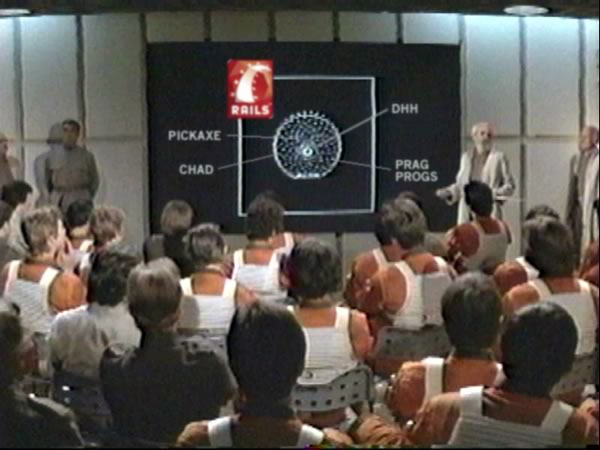In his now infamous Rails is a Ghetto rant, Zed Shaw stated that his favourite Ruby MVC web app framework is Merb (short for “Mongrel plus Erb”). I heard great things about it online and right from the mouth of local Ruby hero Hampton Catlin (the guy behind HAML), who has his own writeup about Merb.
The Mythical 5%
You’ve probably heard the statement about how 5% of programmers are 20 times more productive than the other 95% (or read essays to that effect). In this commencement address at Neumont University, Bruce Eckel asks the question: So how do you become one of these mythical 5%?
Programming is Hard, Let’s Go Scripting…: Larry Wall’s latest essay at Perl.com, in which he takes a tour of a number of programming languages and the degrees of freedom programming language designers have.
Unwitting Facebook Spokesmodels
If you’re going to become a fan of a business on Facebook, you’d better make sure that your profile photo is a good one — you might end up as that company’s unwitting spokesmodel!

If you’ve been following the usual programmer and tech new sites, you’ve probably read (or at least heard of) Zed Shaw’s rant, titled Rails is a Ghetto. If you haven’t read it yet, go there now, give it a quick read and come back. I can wait.
High-spirited stuff, isn’t it? As you might expect, there have been a number of interesting responses to Zed’s polemic, but only one made me laugh out loud — it’s this entry in Jesse Stay’s blog:
Ruby on Rails is weak right now, it’s breaking apart from the inside. Now is the time for the Perl community to show its strength and unite in an effort to make Perl once again the most used platform on the web!
Perhaps it’s time for Larry Wall to update his maxim about the great virtues of a programmer: it should now be laziness, impatience, hubris and revenge fantasies.
My Favourite Quote About XML

A recent comment to this article in Coding Horror reminded me of the joke about XML:
“It has been said that XML is like violence; if a little doesn’t solve the problem, use more.”
Lesson from a Criminal Genius
(The idea for this post came to me while posting this story on my personal blog, The Adventures of Accordion Guy in the 21st Century.)
Take a look at the close-up of the front page of the Lewiston Tribune, a newspaper in Lewiston, Idaho. Note the two pictures, which are for different stories: one of a guy making a Christmas sign, the other being surveillance camera footage of a thief. Do you see something odd that connects the two otherwise-unrelated pictures?

Click the photo to see a full-size PDF of the front page of this newspaper.
Luckily someone at the local police read the paper, put two and two together and made the arrest.
My first thought after reading the story was “Why didn’t the photo editor or layout people at the paper figure it out?”.
Then I wondered what would’ve happened if the photos hadn’t been laid out on the same page. The connection between the guy making the sign and the wallet thief wouldn’t have been as apparent, and there’s a chance that he wouldn’t have been arrested.
That’s when the not-so-obvious lesson from this incident came to me (the obvious lesson being “when committing a crime, don’t wear clothing that easily identifies you). That lesson comes in two flavours:
- The layout of information matters. (I’m half-expecting Edward Tufte to burst into the room, point at my monitor and go “See? SEE?!“)
- Sometimes the best way to solve a problem is to rearrange the given information.
This can be applied to all sorts of areas in development:
- On the front end, the way you present information in the user interface can directly affect the way it’s analyzed by your users and can even affect the conclusions they come to.
- On the data side, the way you cross-reference (or, if you prefer the new term, “mash up”) data can make the difference between an app that just collates information and one that does something useful and provides new insights.
- In your code, the way you arrange it can make it more or less understandable, and therefore more or less maintainable.